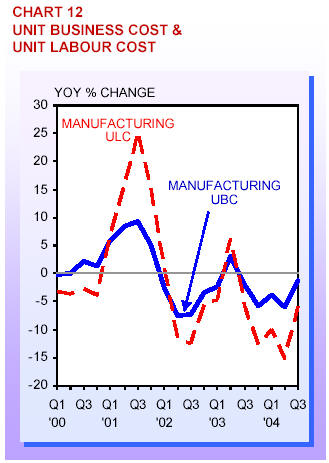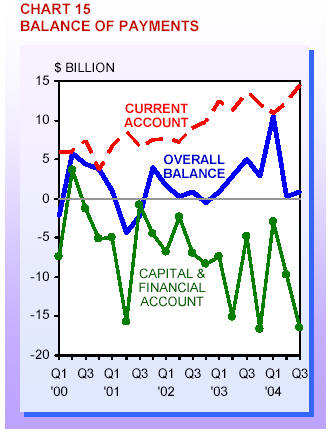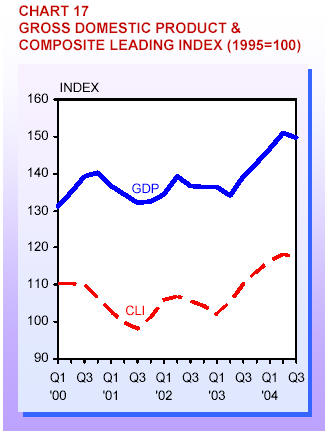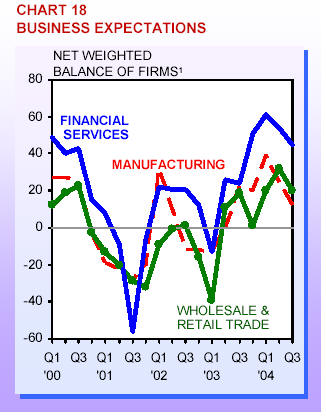|
CHARTS
1 - 9
Annex
Labour Market

Total employment
rose by 16,600 in 3Q04, the strongest quarterly gain in three
and a half years. Employment in both the goods producing and
services producing industries grew more strongly than in 2Q04. A
total of 7,200 jobs were added in the goods producing
industries, compared with 2,900 previously. The services
producing industries added 9,400 workers, higher than the 8,000
added in the earlier quarter. Retrenchments also eased to a new
low, numbering 1,700 – a reduction of 17% from the previous
quarter. Strong employment creation led to a significant decline
in unemployment. The seasonally-adjusted unemployment rate fell
to 3.4%, from 4.5% in June.
Labour
Productivity

The moderation of
economic growth in 3Q04 led to a slower rise of total labour
productivity of 5.0%, compared with the 11.0% recorded in 2Q04.
The construction sector suffered the largest fall in labour
productivity, declining by 6.8%. The business services and
financial services sectors saw smaller declines of 1.1% and 0.5%
respectively. The largest gains were seen in the wholesale and
retail trade sector (12.9%), transport & communications sector
(7.7%), and the manufacturing sector (5.6%).
Business Costs

The unit labour cost
(ULC) index continued its downward trend, posting its fifth
consecutive decline of 4.9% in 3Q04, after falling by 10.0% in
the second quarter. The unit business cost index (UBC) of
manufacturing posted a smaller drop of 1.3% in 3Q04, compared to
the 5.9% decline in the quarter earlier. During the quarter, the
manufacturing ULC fell by 5.8%, after falling by 15.3% in the
previous quarter. Services cost posted a rise of 1.4%, as the
weighted rise in the costs of trade and transport, financial
services and other services outweighed continued declines in
premise rentals, warehousing rates and telecommunications
charges. Government rates and fees also rose by 4.5%, up
slightly from the 4.4% gain recorded 2Q04.
External Trade

Singapore’s external
trade grew a brisk 27.8% in 3Q04, following the growth of 26.5%
in 2Q04. Total exports expanded by 25.2%, on the back of a 25.7%
gain in 2Q04. This mainly reflected the robust growth of
domestic exports, which rose to 25.3% from 22.8% in 2Q04. The
rate of NODX growth rose to 20.8%, from 21.1% in 2Q04. On the
other hand, the rates of growth in re-exports and non-oil
imports (excluding aircraft and ships) moderated from the
previous quarter. In volume terms, total trade continued to turn
in a strong performance of 25.0%, after a 26.0% rise a quarter
earlier.
Investment
Commitments

Fixed asset
investments amounting to $1.9 billion were committed in the
manufacturing sector in 3Q04, down from $2.2 billion in 2Q04.
When fully implemented, these projects are expected to generate
a value added of $1.3 billion and create about 2,300 jobs, of
which 53% are for skilled professionals and workers. Investment
commitments in the services industries promoted by EDB in 3Q04
amounted to $511 million in total business spending. Upon
realisation, these projects will generate a value added of $826
million and create about 2,300 jobs, of which 81% are for
skilled professionals and workers.
Balance of
Payments

The current account
surplus rose to $14.4 billion in 3Q04, up from $12.2 billion in
2Q04, as a result of higher surpluses in both the goods and
services accounts, even as the income balance recorded a larger
deficit. The net outflow in the capital and financial account
increased to $16.4 billion, up from $9.7 billion in 2Q04. This
largely reflected the rise in direct investment abroad.
Singapore's overall
balance of payments turned in a larger surplus of $0.8 billion
in 3Q04, compared to $0.3 billion in 2Q04. Nevertheless, the
official foreign reserves fell to $173 billion in the quarter
(equivalent to 7.8 months of current imports), from $175 billion
in the previous quarter.
Consumer Price
Inflation

The CPI moderated to
1.7% in 3Q04, down slightly from 1.9% in 2Q04. Costs of
healthcare (5.9%) and education (3.9%) saw the largest gains.
Both the cost of food and miscellaneous items rose by 2.3% each.
The higher food prices were due to the recent poultry ban. The
cost of transport & communications also increased by 1.8%, as a
result of dearer electricity and petrol due to higher oil
prices. Helping to keep a lid on inflation, clothing prices and
housing cost declined by 0.5% and 0.3% respectively.
Outlook for 2004
and 2005
The Singapore
economy expanded by 9.1 per cent in the first nine months of
2004. Other than strong external demand for Singapore’s exports,
which accompanied the exceptional global economic growth this
year, the headline growth figure also reflected the economic
recovery from the impact of SARS.
External demand is
expected to remain supportive of economic growth in the
near-term. While the rate of global economic growth is expected
to ease in 2005, the IMF has projected that it would remain well
above levels seen between 2001 and 2003. The robust rates of
growth seen in the US and in Japan this year are likely to be
followed by growth at more sustainable rates, driven mainly by
improving labour market conditions in these economies. Economic
growth in the EU is also seen to moderate slightly next year, as
exports grow at an easier pace.
Similarly, economic
growth rates in key Asian economies are projected to ease in
2005. China, an important driver of global economic growth in
2004, is likely to succeed at achieving more sustainable rates
of economic growth in the next few quarters.
Slower growth is
also expected in the other major Asian economies, as the pace of
export growth eases in line with more moderate world demand for
electronics. Worldwide semiconductor sales are expected to
remain healthy for the rest of 2004, but growth will likely slow
sharply in the following year.
An important risk
factor to economic growth in 2005 is developments in oil prices.
Due to the small spare capacity in the oil industry, a
significant production disruption in any of the key producer
countries could send prices sharply higher. While the world
economy is better able to handle the impact of higher oil prices
than in the 1970s, further increases could dampen growth
nevertheless.
On the domestic
front, the recent improvement in the unemployment situation and
higher asset prices should provide support for domestic
consumption going forward. Growth of domestic investment,
however, is likely to ease, partly due to the slowdown in global
electronics demand. Forward looking indicators in Singapore are
also pointing to slowing growth in the near term, reflecting the
uncertain outlook for global economic conditions.

Barring unforeseen
circumstances, the MTI has narrowed the 2004 economic growth
forecast from 8.0-9.0 per cent to 8.0-8.5 per cent. The
narrowing of the forecast to the lower band reflects the slower
growth in the third quarter as a result of recent developments
such as lower-than-expected biomedical output as well as the
uncertainty of higher oil prices. It also reflects the
possibility of a further moderation of growth in the fourth
quarter. For 2005, the preliminary forecast for economic growth
remains at 3.0-5.0 per cent, in line with an expected
deceleration of the global economy and falling semiconductor
sales.

1 The
y-axis of the chart on business expectations represents the net
weighted balance of companies that predict an improvement in
business situation. This is derived from the weighted percentage
of companies in the survey that predict better business minus
the weighted percentage of companies that predict worse
business.
Source:
Ministry of Trade and Industry
Press Release 17 Nov 2004 |